Peter Richardson, editor of the Book Palace Books Fleetway Pocket Library collection Psycho War Stories, available now, reveals both the joys and pitfalls of bringing these classic British comic digests back into print…
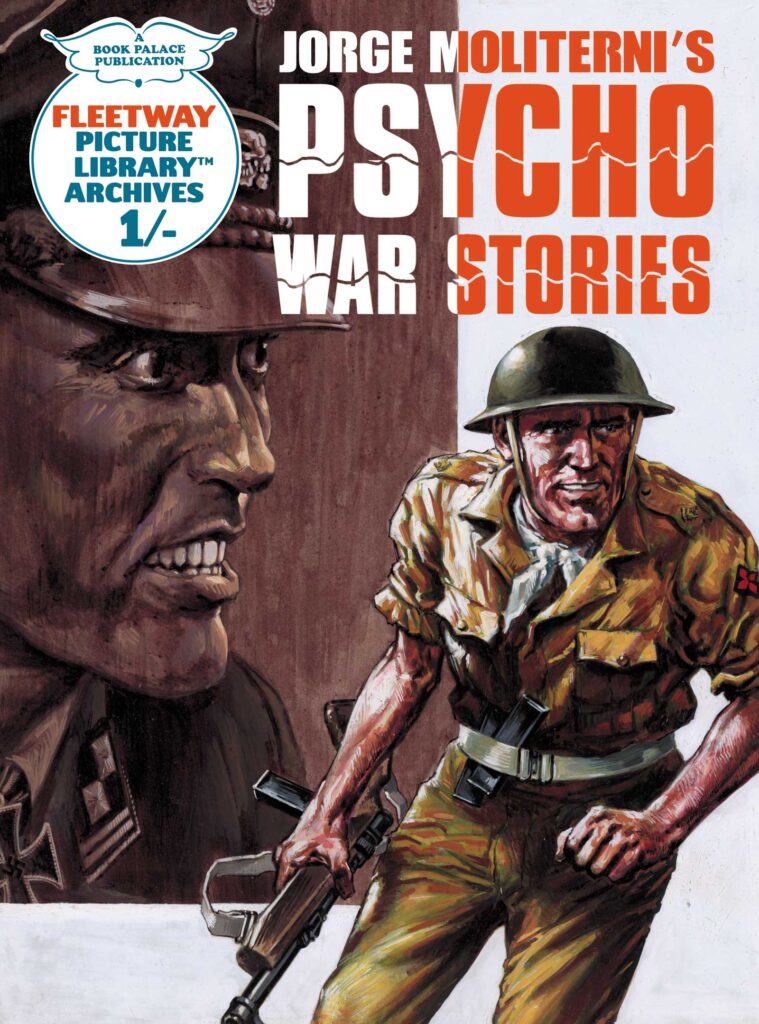
When Book Palace Books began re-issuing the Fleetway pocket libraries, they tapped into a genre that was familiar to boys (and girls) growing up through the 1950s to the 1970s. These comics were distinguished by having some of the best artists and writers working on stories that transported children back to days when knights were bold, pirates sailed the seven seas and jack-booted Nazis and dangerous Japs swarmed over much of Europe and the Far East.
The publishers of these little gems covered all genres, with series under the banners of Thriller Picture Library, Cowboy Picture Library, Super Detective Picture Library, Schoolgirls Picture Library. For war story fans, on offer were War Picture Library, Air Ace Picture Library, Battle Picture Library and War at Sea Picture Library.
It was the latter comics that were by far the most successful, initially devised as a series of titles to be inserted into Thriller Picture Library’s schedule, the decision to launch the comics under the banner of War Picture Library proved an inspired decision by the editorial team at, what was then, the Amalgamated Press. Cautiously released at two issues a month, it wasn’t long before sales returns convinced the editor, Ted Bensberg, to up the schedule to three a month. The three a month soon became four a month, and by the 1970s the titles were being released at eight a month, reprints of the early issues bolstering the production schedule.
The comics were written by men who, often, had seen action on the front lines. David Satherly had seen action in Combined Operations Special Forces, A. Carney Allen had been a major in the Black Watch, Norman Worker had served in the Royal Armoured Corps in India, Donne Avenell saw service in the royal Navy, where he worked as a telegraphist, while Eric Hebden saw action in the Far East and ended the war as a Major sitting on the War Crimes Commission in Singapore.
All were superb writers, able to flesh out their characters so that the reader really engaged with them before the action started.
The artwork was equally brilliant – some was homegrown but, as a result of the international connections made by the likes of artist’s agents Bardon Press, the very creme-de-la-creme of Italian and Spanish Studios, later joined by Argentinian artists, became familiar to readers of these comics. The covers were also superb: Giorgio D’Gaspari, a noted Italian painter of paperback covers and movie posters, created 32 of the first 50 War Picture Library covers, ably abetted by artists such as Nino Caroselli, Alessandro Biffignandi, Jordi Penalva and Pino Dell’ Orco.
But representing these stories in a manner and format best reflecting the work that went into creating them is no easy task. There have been previous attempts to represent these comics, but while the cover art survived, much of the interior art was torched in the early 1990s, when the sheer volume of artwork being shuffled from one warehouse to another got too much for company money men to condone. This has resulted in several very compromised collections being released, the difficulties of reprinting exacerbated by the cheap printing on newsprint of the comics that the editors of these recent collections had to rely upon.
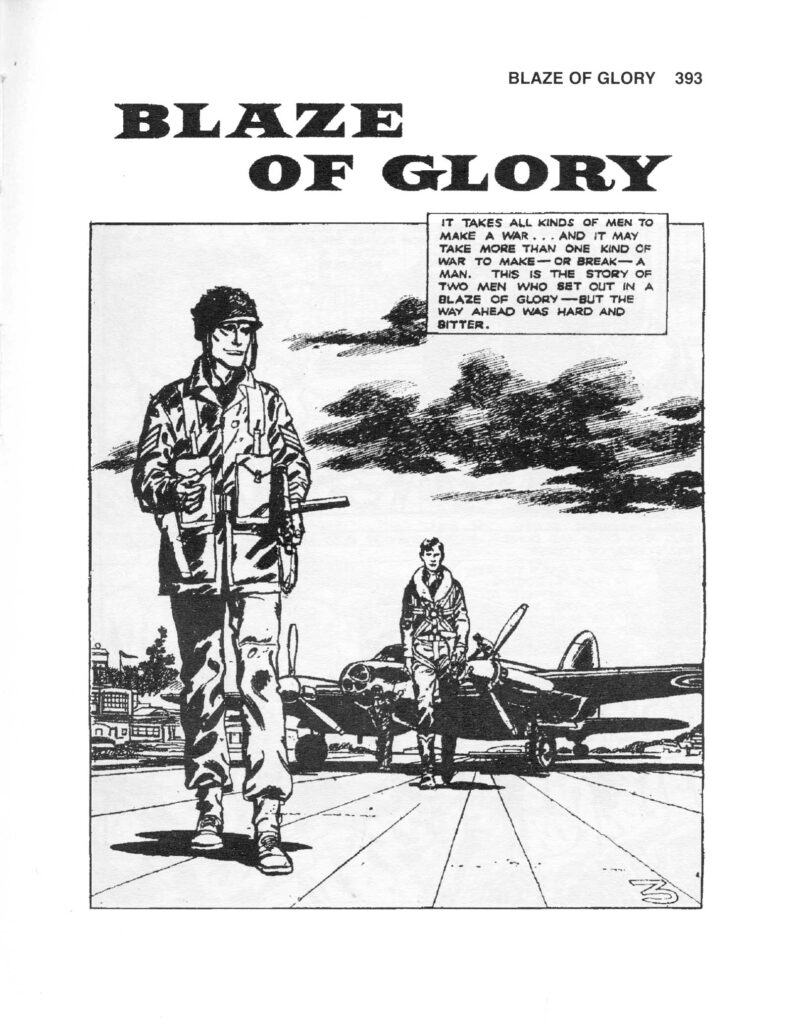
For both the recently published Psycho War Stories and last year’s Frontline War Stories, I eventually decided to not only reset all the balloons and captions, but also completely reconstruct the art. This was not a decision lightly taken. Apart from the hours and hours of work involved, there is also the thought that you are embarking on a process which could undermine the artist’s work. However, in the case of artists who were drawing for black and white reproduction and using cross hatching to augment their line work, the thought of digitally attempting to preserve the original art, while increasing the contrast (thereby eliminating the crud in the piss-poor reproductions) will inevitably still involve erasing and redrawing much of the line-work.
The restoration work was all done digitally, using a program called Clip Studio Paint, favoured by many comic book artists, including Dave Gibbons and Nik Poliwko. The software benefits from the ability to mimic brush and pen inking superbly. It was light years ahead of Photoshop when it first appeared in 2001 and has gone on to make huge strides in performance over the intervening years. It now offers users the ability to generate fully rendered art, in a variety of mediums.
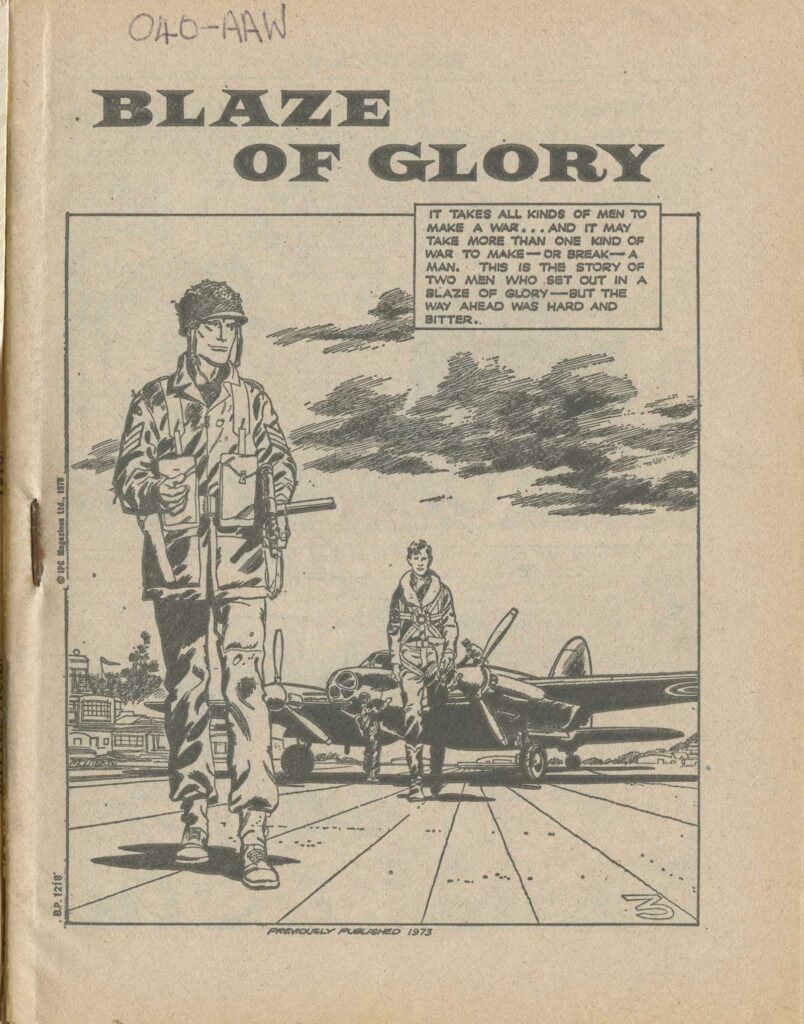
When restoring each story, I first made high DPI scans of the original comics pages, using multiple copies of the comics to source the best iteration of the printed pages. Familiar problems such as slippage of the printed plates creating double lines, infill of dense cross-hatching and, at the other extreme, loss or breakage of lines being recurring factors.
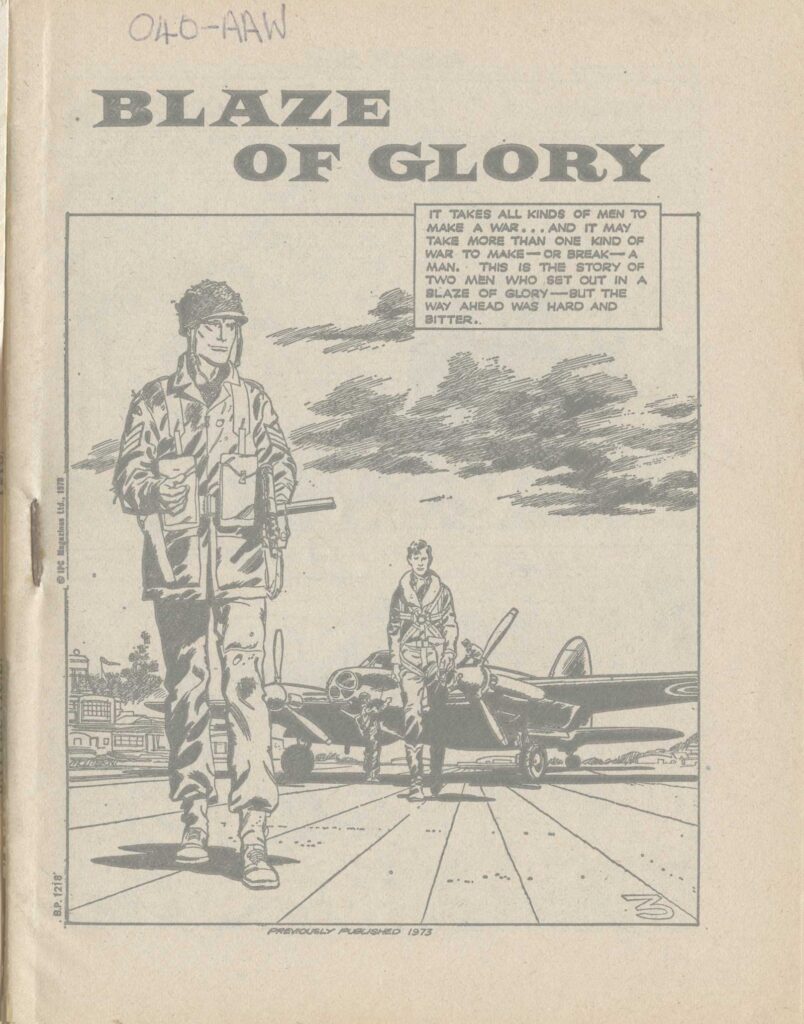
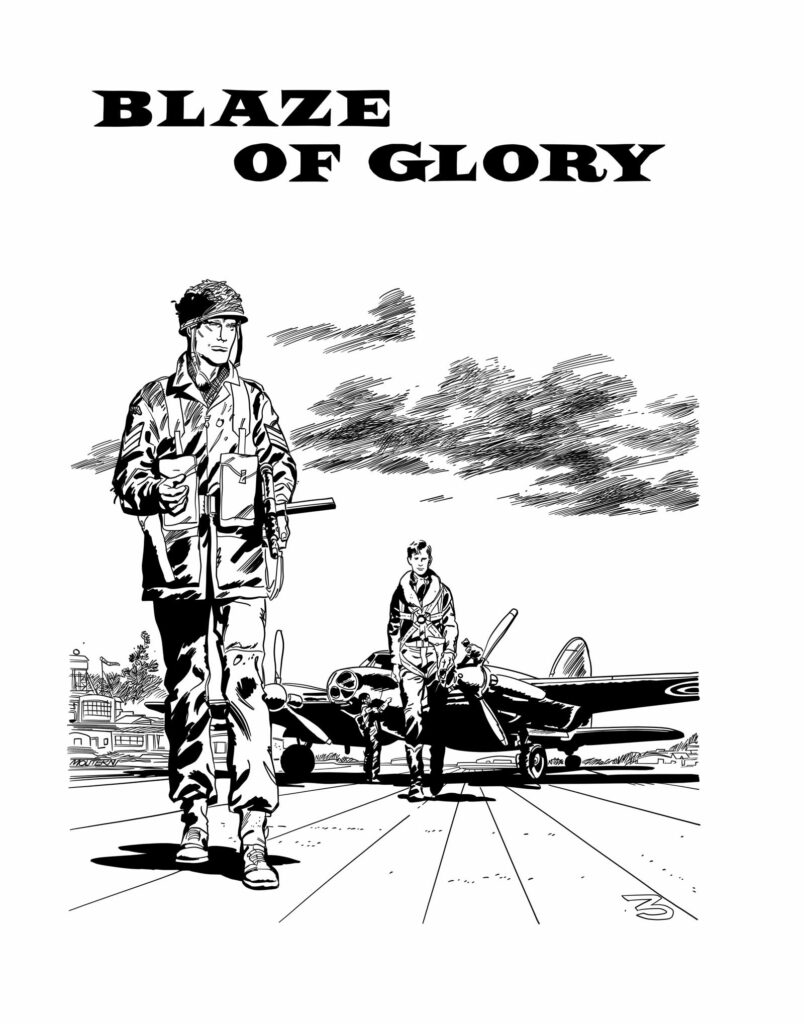
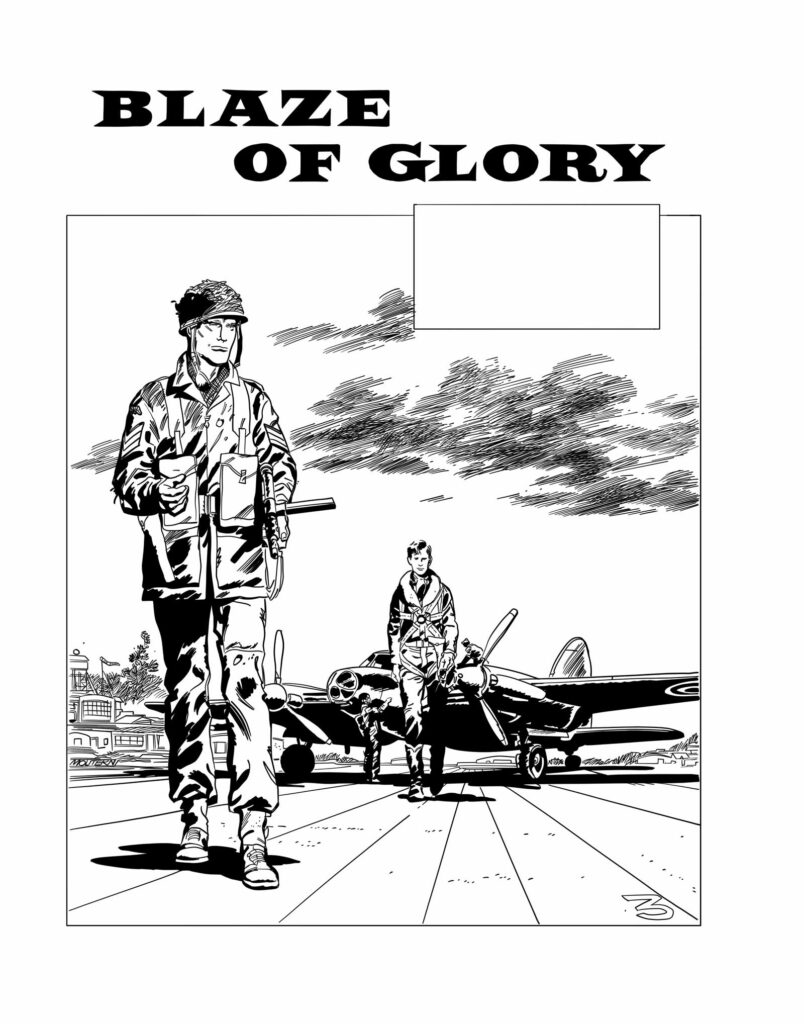
Once the pages were open in Clip Studio Paint, I would create a semi opaque layer above the image to be traced and then above it I would create a layer to (digitally) ink on. Horses for courses rules applying, I would select suitable brushes for solid areas of black and brush or pen for line work.
To begin with, Gino D’Antonio would use a lot of brush work in his art, latterly he would opt for pen. With Jorge Moliterni, he always used pen for his line-work adding brush to create solid blacks. In contrast to D’Antonio, he would incorporate a lot of cross-hatching, especially for nighttime scenes. In repro a lot of these images become a mishmash of treacly black ink. So, with Moliterni, I had my work cut out for me, especially operating under the rule of don’t speculate too much about what isn’t there, only add what you can see. Forty plus years working as a commercial artist across a wide variety of media and mediums came to my aid.
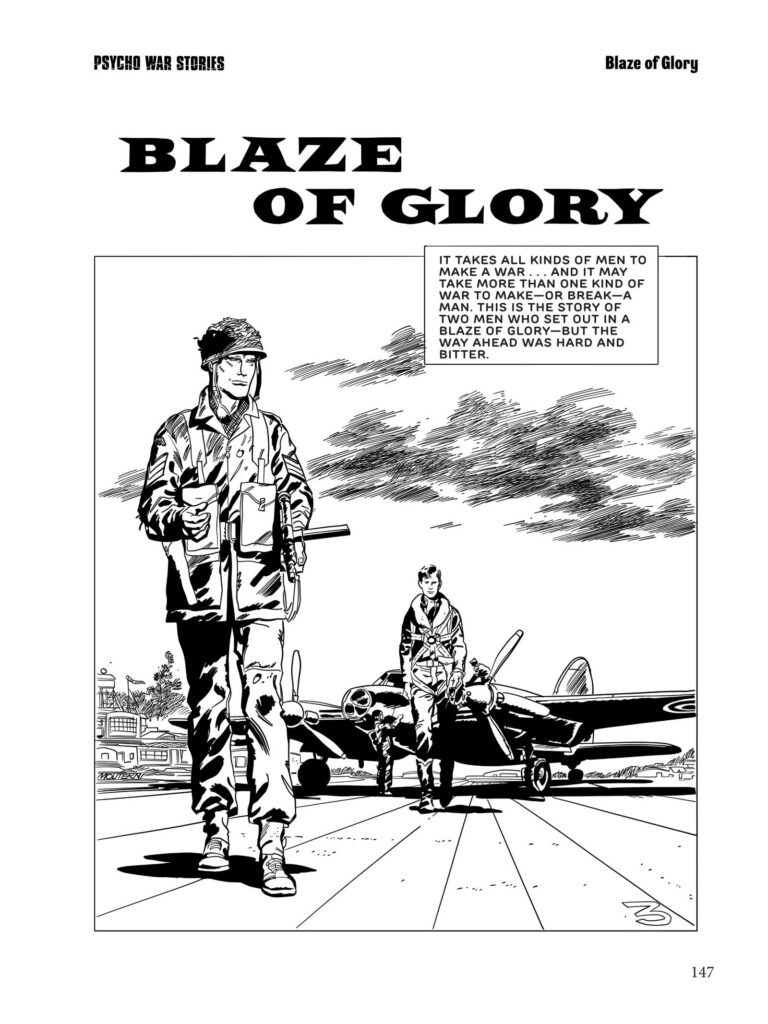
Then there was the matter of the lettering. Unlike DC Thomson’s Commando pocket war comics, each of Fleetway’s productions was hand-lettered, giving the stories an added warmth. Eschewing the idea of testing my limited lettering abilities to the max, I opted for a set text conforming as far as possible to the look and feel of the original lettering. Following closely the spacing of the original and adding emphasis when required.
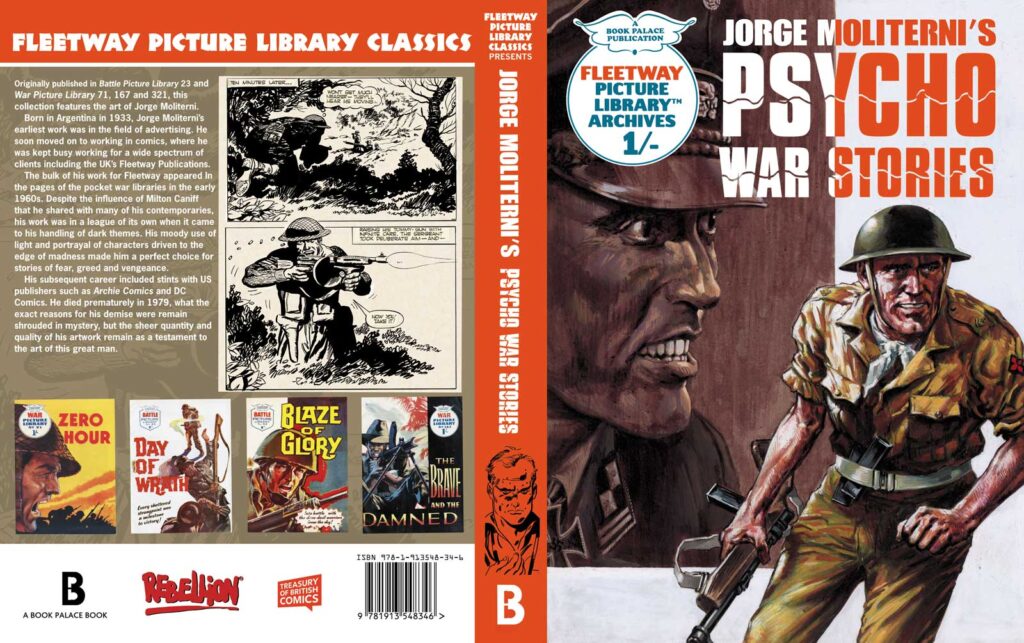
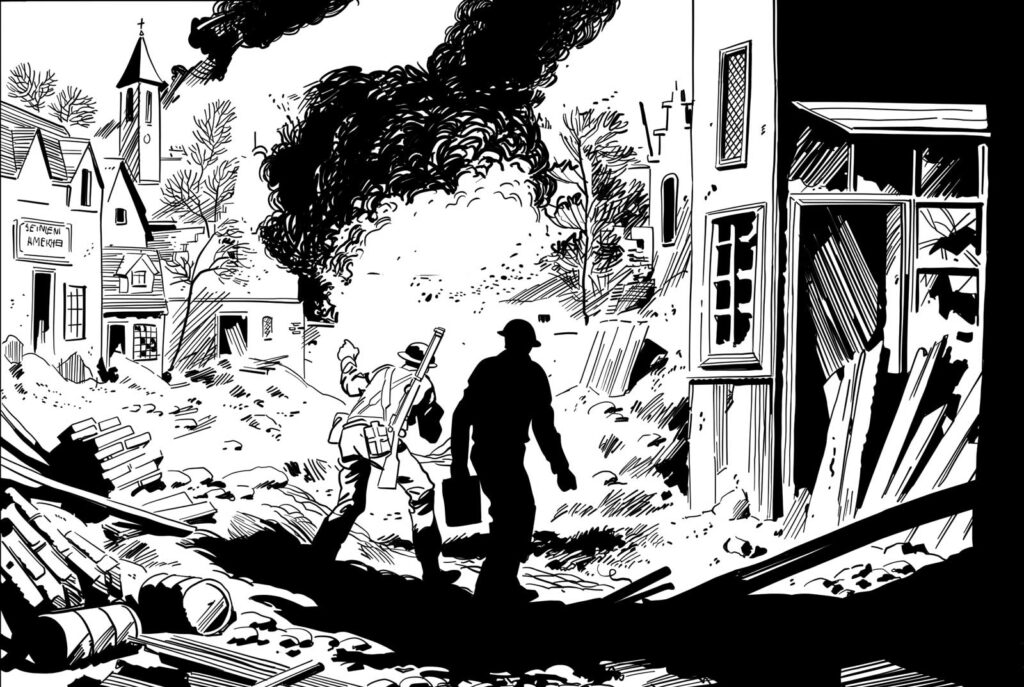
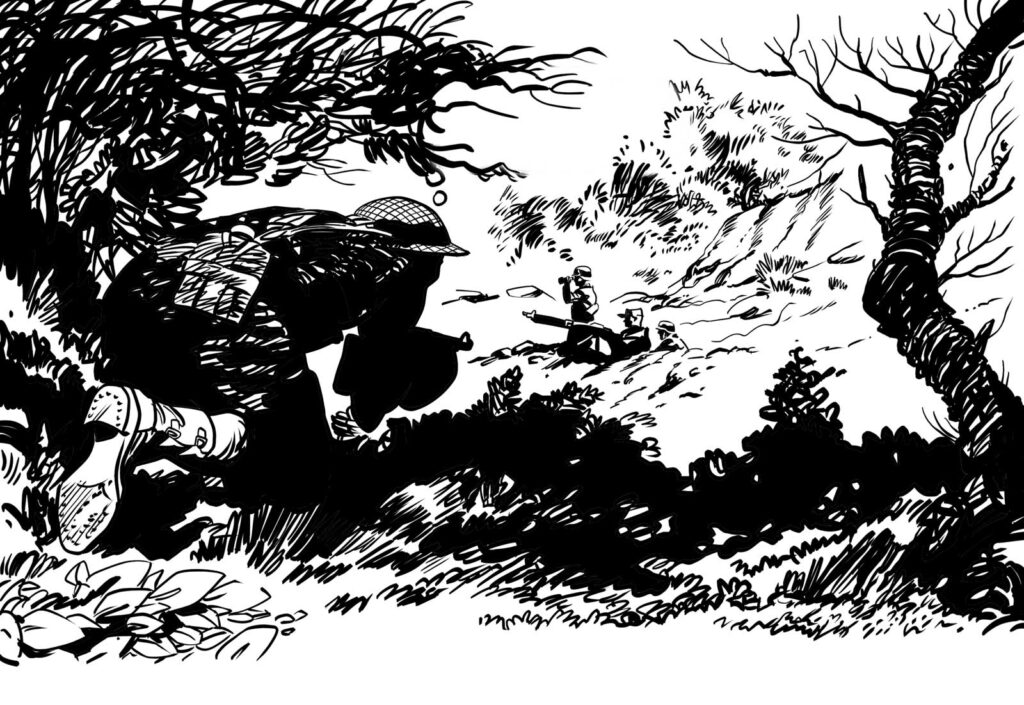
The work involved long hours, but did enable me to catch up with a backlog of audio books. I would spread the work around other activities, such as writing or working on other commissions. In all I would say that each collection of stories took about a year to complete.
All in all, the experience was very rewarding. I came away from the project with an even greater appreciation for these fine productions than I had had at the outset. I might be tempted to create one more collection, as the art of Renzo Calegari is also richly deserving of adding to the series.
Peter Richardson
• Order Fleetway Picture Library Classics: Jorge Luis Moliterni’s Psycho War Stories direct from Book Palace Books here
Our thanks to Peter for taking time out of his busy schedule to shed light on how much work goes into restoring classic comics for modern reprint, challenges faced by others as they strive to bring amazing stories back into the limelight…
Renzo Calegari’s War Comics
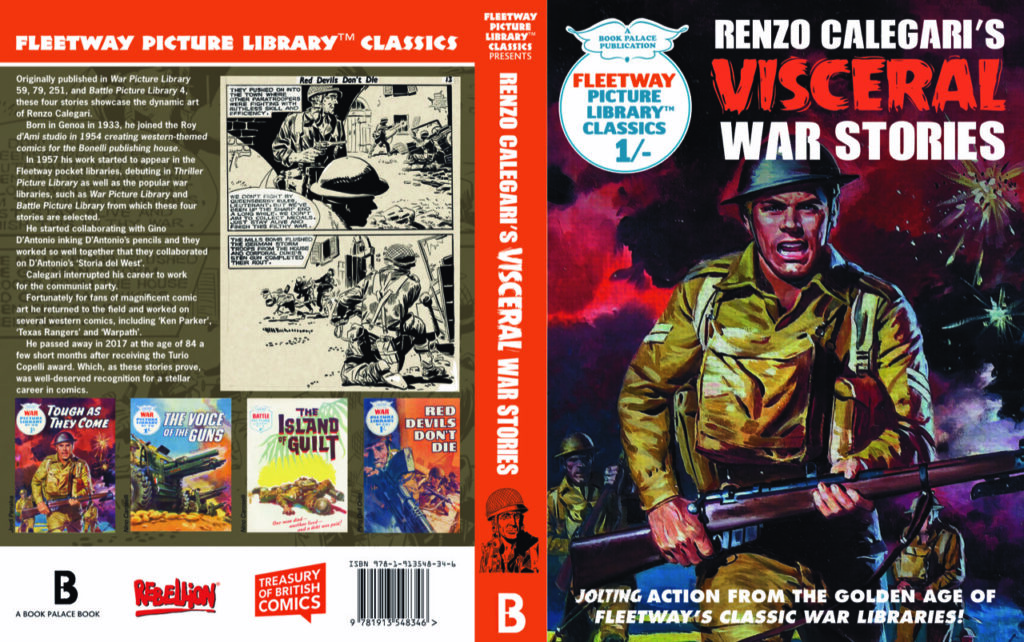
Book Palace Books are considering a collection of Renzo Calegari’s war comic work for Fleetway. An Italian comic artist with a dynamic, gritty style, born 5th September 1933, passing 5th November 2017, he mainly worked on western comics for several incarnations of the publishing house Bonelli.
As Lambiek notes, he is especially known for his highly detailed drawings of the American prairies in Gino D’Antonio’s Storia del West (1967), the massive, long-running story of the old west told through through the lives of two families; but between 1957 to 1966 he also drew British war comics such as “Battler Britton” in cooperation with Carlo Porciani.
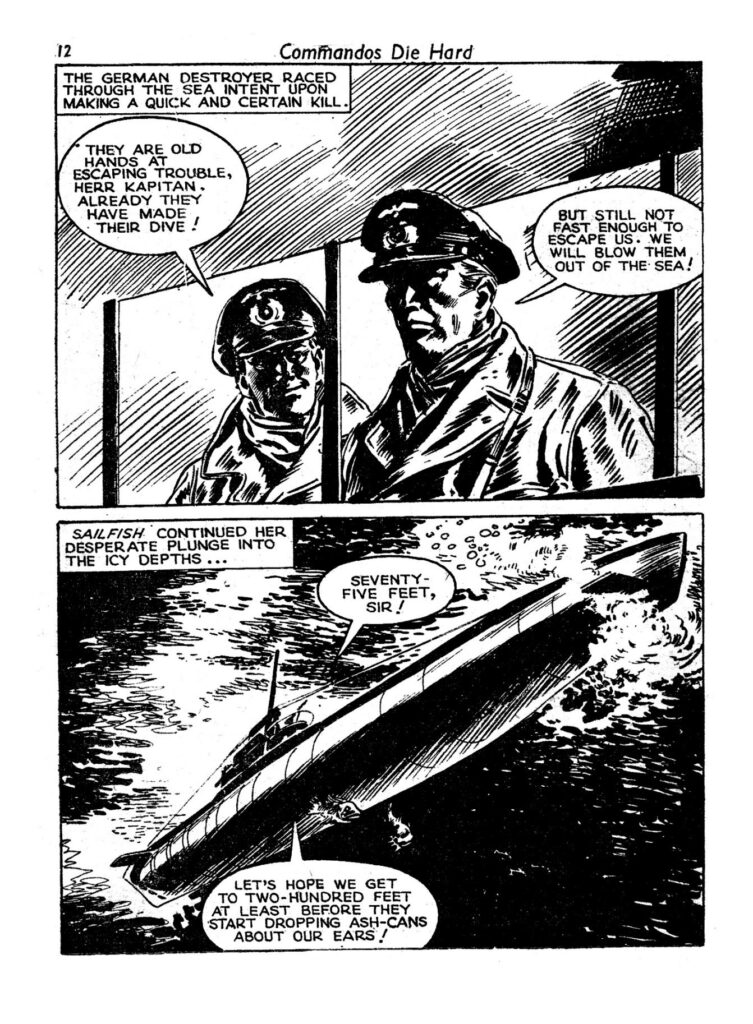
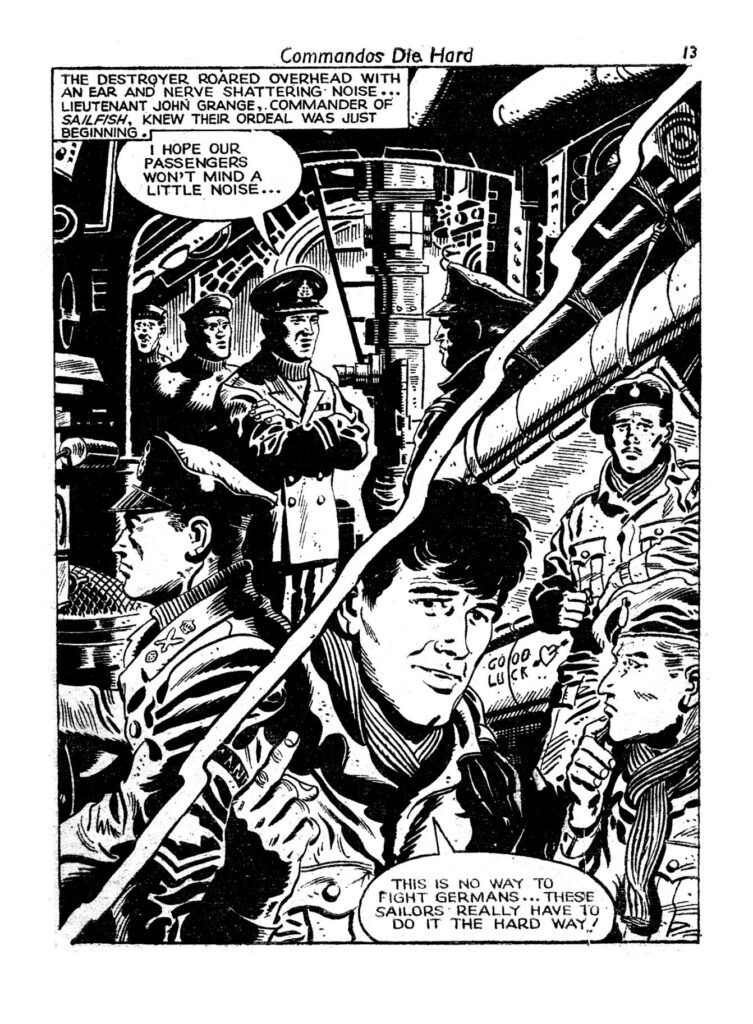
Working with Porciani and other members of the Studio Creazioni d’Ami Studio, Renzo Calegari’s credits on War Picture Library include “Action Stations” (War Picture Library no. 3), “The Gallant Few” (No. 4), “Bombs Away” (No. 9), “Tracy of Tobruk” (No. 11), “Crash Start” (No. 16), “Commandos Die Hard” (No. 17) and other early War titles, as well as “The Rats of Tobruk”, the first issue of Battle Picture Library.
He also contributed art to Thriller Picture Library (on “Dick Daring”), and Cowboy Picture Library (on “Billy the Kid”).
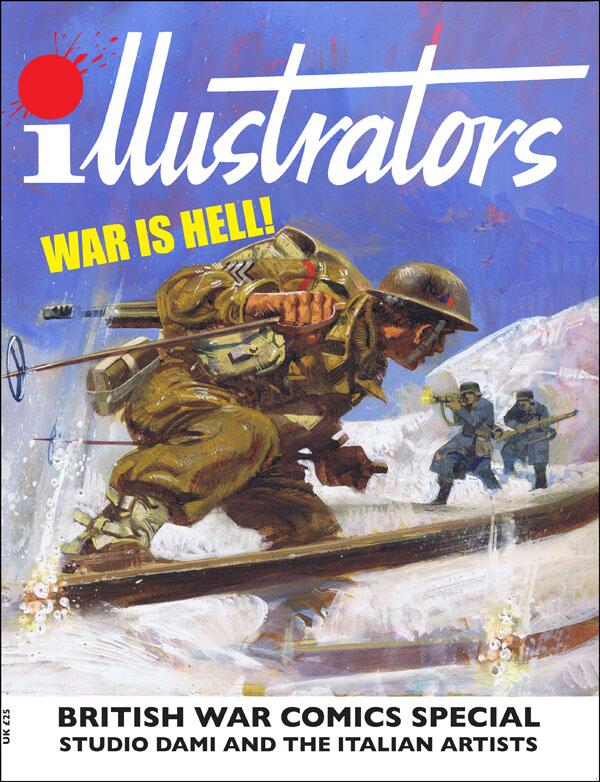
Renzo also shared pages with another artist at Studio Creazioni d’Ami for his work for War Picture Library, labelled as Creazoni Dami #2 in Steve Holland and David Roach’s War Libraries: The Fleetway Picture Library Index: Volume 1, published in 2017, his last work appeared in issue 27.
To date, no one has been able to identify the other artist, but they both had a very similar style.
“There’s a lot more that’s really worth looking at just in terms of the way these artists handled staging, lighting and character development which is to the fore in [Calegari’ extract’s work],” Peter has previously noted, “with the foreground face at the top of page 16 as a perfect example of great storytelling – I mean the guy exhibits classic signs of combat fatigue and world weariness all at the same time. This is what makes a great comic artist – storytelling every time.”
Calegari left the comics field in 1969 to spend all his time on political activities with the Italian communist party, but returned in 1977 to draw the series Welcome to Springville, written by Giancarlo Berardi (author of Long Scotty Files) for Skorpio. Later, he collaborated on magazines such as Il Giornalino, and strips such as “The Orient Express Train” and “Zodiaco”. He also drew a number of the western covers published by Frontiera, and created the “Boone’ western series for Il Giornalino; and cooperated on such series as Ken Parker and Tex Willer.
Head downthetubes for…
• The Cabinet of Renzo Calegari – War Is Hell Dept. Take 4
• Lambiek Profile: Renzo Calegari
• Fumetto Logica: Renzo Calegari Obituary (in Italian)
• Lambiek Profile: Carlo Porciani
• Wikipedia: War Picture Library
• Vic Whittle’s War Picture Library Index
Battle Picture Library, War Picture Library and other Fleetway war comic titles © Rebellion
Categories: British Comics, British Comics - Collections, British Comics - Current British Publishers, Comic Creator Spotlight, Comics, Creating Comics, downthetubes Comics News, Features